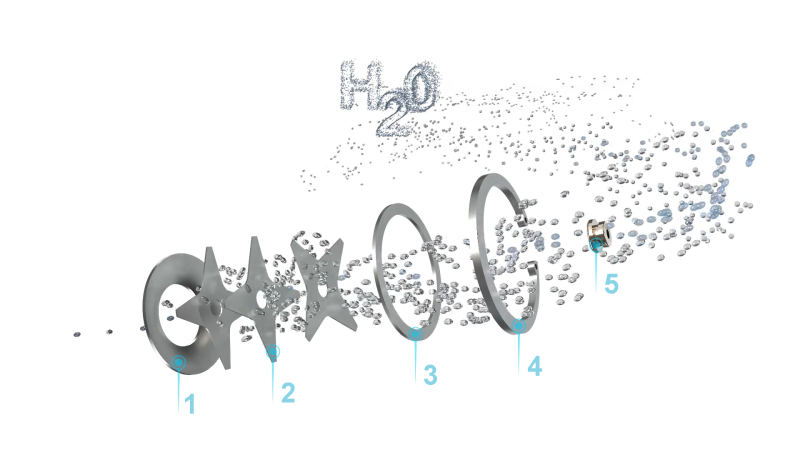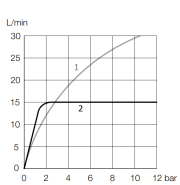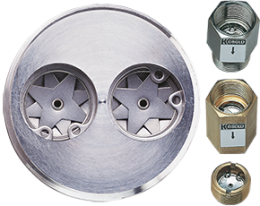KOBOLD Instruments Inc • 1801 Parkway View Drive • 15205 Pittsburgh, PA • Tel: +1 412 788 2830 • E-mail: Please activate JavaScript • visit koboldusa.com
 Flow Restrictors
Flow Restrictors

Knowledge: Flow Restrictor
A flow restrictor will define the flow of liquid in a pipe system to a determined value. This not only helps to prevent waste, but also provides an independent controlled mechanical in-line regulator device to a system. Because the flow is kept stable over a wide range of pressure and flow rates, a flow restrictor is ideal for use in distribution systems that serve a variety of consumers. The flow restrictor is similar to a valve and keeps the flow within a system constant, even with strong pressure fluctuations. A local lowering of the liquid flow is thus reliably avoided.
How can I limit the flow rate of water?
So-called flow restrictors are used to reduce the water flow. They are inserted into the pipe system and reduce the flow capacity. For example, a flow rate of 10 liters per minute is reliably reduced to a flow rate of 2 liters per minute.
How does a flow restrictor work?
A flow restrictor is similar to a brake that limits the flow of water or water-like media to a selectable value with minimal effort. Especially in systems with many consumers and the associated pressure fluctuations due to switching on and off, the flow restrictor ensure a good balance by ensuring that the desired flow rate is not exceeded in any case. The constant flow is generated by crossed, riveted stainless steel spring plates. Depending on the differential pressure, the gap opening between the spring stars and the sealing surface is continuously varied. Decreasing differential pressure causes the opening to increase in size, and an increase in pressure correspondingly decreases it, thereby keeping the amount of liquid flowing through the device constant. It allows small streams of water to pass unhindered through recesses. It reliably reduces the water flow to a specified value at high pressures.

1 - Pan: Stainless steel 1.4301; 2 - Spring Star: Stainless steel 1.4310; 3 - Ring: Stainless steel 1.4301;
4 - Circlip: Stainless steel 1.4322; 5 - Tubular Rivet: Stainless steel 1.4301
Differential Pressure Curve
Example of a flow rate of 15 l/min in relation to a fixed orifice:

1 - fixed orifice 2 - REG flow restrictor
While a flow restrictor with a fixed orifice (1) no longer correctly limits at higher pressures and incorrectly lets too much liquid through, the REG flow restrictor from KOBOLD (2) reliably limits the flow to the set value, here: 15 liters per minute.
What are the advantages of flow restrictors?
Flow restrictors primarily limit the flow. According to experts, consistent use of flow restrictors can save 35%-65% of water used in industry. In addition, they ensure a constant flow, which is important for sensitive fittings.
How good are flow restrictors?
Flow limiters usually have no moving parts, do not require an energy supply, are very durable and maintenance-free. With KOBOLD, this is made possible by a special all-metal construction. Other manufacturers use plastics for the control panel instead and construct them statically. The molecular structure of the plastics deteriorates over time due to aging, temperature and chemical influences and the flow behavior changes. It becomes problematic and, above all, expensive if this property is underestimated or not pointed out.
Do I have to pay attention to the direction of flow when installing a flow restrictor?
Yes absolutely! This is marked by an arrow on the KOBOLD REG flow restrictor.
For which flow rate is a flow restrictor suitable?
A single element of a flow restrictor (control insert) of the REG from KOBOLD is suitable for water volumes of 0.5 ... 40 l/min. Multiple elements with flow rates up to 560 l/min are available. Call us or send us an email.
How can I calculate the total flow rate for a multiple element?
The flow rate results from the addition of the individual flow restrictor elements (control inserts). Example: the flow rate of 55 l/min is obtained with a restrictor with two control inserts (30 l/min plus 25 l/min).
What connections do flow restrictors have?
The flow restrictor REG from KOBOLD can be supplied with the threaded connections G ½, G ¾, G 1½, G 2, G 2¼, G 2½ and ¾" NPT on customer request. Multiple elements are available as standard up to DN 100. Even larger diameters are possible as special designs .
For which temperatures are flow restrictors suitable?
Flow restrictor from KOBOLD are suitable for temperatures of up to 300 °C.
What pressures are flow restrictors suitable for?
Flow restrictor from KOBOLD are suitable for pressures of up to 200 bar.
What is special about flow restrictor from KOBOLD?
The flow restrictor REG from KOBOLD reliably limits the water flow at high pressures to a specified value. Flow restrictors from other manufacturers often do not constantly reduce the water flow. If the water pressure increases with overaged plastics, then more water will flow through the fitting. Thanks to its unique design, the flow restrictor REG from KOBOLD ensures a constant flow rate for life.
What materials are flow restrictors made of?
Flow restrictors are usually made of metal or plastic. Flow restrictor from KOBOLD are made of brass or stainless steel, without any plastic parts.
How do I choose a flow restrictor?
We will be happy to help and advise you on your selection! Visit our website www.kobold.com. Call us or send us an email.
See the product page for more flow restrictor applications.





